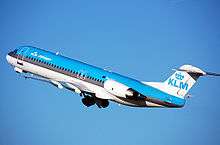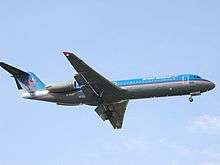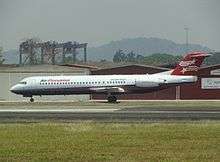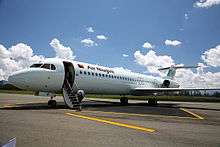Fokker 100
| Fokker 100 | |
|---|---|
 | |
| Montenegro Airlines Fokker 100 in 2010 | |
| Role | Narrow-body Regional jet airliner |
| National origin | Netherlands |
| Manufacturer | Fokker |
| First flight | 30 November 1986 |
| Introduction | 3 April 1988 with Swissair |
| Status | In service |
| Primary users | Alliance Airlines Virgin Australia Regional Airlines Iran Air QantasLink |
| Produced | 1986-1997 |
| Number built | 283 |
| Developed from | Fokker F28 |
| Variants | Fokker 70 |
The Fokker 100 is a medium-sized, twin-turbofan airliner from Fokker. Low operational costs and scant competition in the 100-seat, short-range class led to strong sales when it was introduced in the late 1980s, but sales fell as competition increased. Production ended in 1997 with 283 airframes delivered. In July 2012, 156 Fokker 100 aircraft remained in airline service with 30 airlines around the world.[1] It was the largest jet airliner built by Fokker before its bankruptcy in 1996. Despite the fact that airlines are currently retiring the aircraft, there are still large numbers in operation in both Australia and Iran.
Design and development
The Fokker F28 Mk 0100 program was announced in 1983 as an updated replacement for Fokker's popular, but superseded, F28 Fellowship design. Marketed as the Fokker 1000, the design was based on the original F28, but featured modern avionics, new-generation Rolls-Royce Tay turbofan engines, and a redesigned wing. However, the most noticeable difference was the longer fuselage, which increased seating by 65% from 65 in the original F28 series to a maximum of 107 in a three-by-two single-class arrangement. The new wing is claimed by Fokker to be 30% more efficient in cruise, while still keeping the simplicity of a fixed leading edge. The cockpit was updated with a Rockwell Collins DU-1000 EFIS. Like the Fokker Fellowship, the Fokker 100 features twin rear fuselage-mounted engines and a T-tail, similar to that of the Douglas DC-9 family. The Fokker 100 does not have eyebrow windows above the main cockpit windows as on the Fokker F28.
Two prototypes were built - the first, PH-MKH, flew for the first time on 30 November 1986, and the second, PH-MKC, followed on 25 February 1987. The type certificate was awarded in November 1987. The first deliveries of the Tay 620-15 powered versions started to Swissair in February 1988. American Airlines (75 aircraft ordered), TAM Transportes Aéreos Regionais (now LATAM Airlines) (50 aircraft) and USAir (40 aircraft) were major customers of the Fokker 100 and their aircraft were powered by the more powerful Tay 650-15.
Operational history
By 1991, Fokker had produced 70 units and had orders for more than 230. An extended-range version with additional fuel tanks in the wings was introduced in 1993, and a quick-change passenger/freighter version in 1994, the 100QC. A shorter version was introduced in 1993 as a replacement for the earlier F28, known as the Fokker 70, which removed 4.70 m (15.42 ft) of the fuselage and reduced seating to 80. Studies on the 130-seat Fokker 130 and Fokker 100QC (freighter) did not reach further stages of development. A Fokker 100EJ (Executive Jet) was introduced in 2003 as a conversion from used Fokker 100 aircraft.
Although the design was a success in the marketplace, Fokker continued to lose money due to mismanagement. Eventually, their parent company, Daimler Benz Aerospace, shut them down. Fokker collapsed in 1996 and wound up production in early 1997. Some discussion had occurred about the company being purchased by Bombardier, but the plans fell through. Like any number of designs, the 70/100 was being increasingly squeezed from below by stretched versions of the Bombardier and Embraer regional jets, which also killed off plans for the Fairchild Dornier 528JET/728JET/928JET and an unnamed design from ATR. A proposed stretch version called the Fokker 130 was never built.[2]
An Amsterdam-based group, Rekkof Restart (Rekkof is Fokker spelled backwards) negotiated to reopen the Fokker 70 and 100 lines in 1999, but the deal never completed. Stork B.V. acquired the maintenance business for the aircraft and operated it under the name "Fokker Aviation".[2]
From 2014, the French DGA Essais en Vol used a Fokker 100 as a flying testbed. It replaced a former Dassault Mystère XX's business jet. This Fokker 100 is a former Régional's aircraft. It's called ABE-NG, for Avion Banc-d'Essais de Nouvelle Génération.[3] Alliance Airlines has announced in November 2015 that it shall acquire the entire Austrian Airlines fleet of 21 Fokker 100 and Fokker 70.[4]
Operators
Current operators





.jpg)
Airlines
As of 23 October 2016, 165 aircraft are still in operational use with airlines.[5]
- Air Bagan (1)
- Air Niugini (7)
- Air Panama (5)
- Airquarius (3)
- Alliance Airlines (17)
- Austrian Airlines (12)
- Avanti Air (2)
- Bek Air (8)
- Carpatair (3)
- Caspiy (4)
- Helvetic Airways (5)
- Iran Air (14)
- Iran Aseman Airlines (18)
- IRS Airlines (4)
- Kish Air (3)
- Merpati Nusantara Airlines (1)
- Montenegro Airlines (5)
- Naft Airlines (4)
- Nouvelle Air Affaires Gabon (1)
- Pelita Air (2)
- PGA Portugalia Airlines (2)
- QantasLink (Network Aviation) (18)
- Qeshm Airlines (4)
- Skippers Aviation (2)
- Sky Aviation (1)
- SkyGreenland (1)
- Skyward International Aviation (1)
- Trade Air (2)
- Transwisata Air (1)
- Virgin Australia Regional Airlines (14)
Governments
- Cote d'Ivoire Government (1)
- French Government (1)
- Slovak Government (2)
Former operators
- Aero Mongolia
- Air Berlin
- Air Europe
- Air Express
- Air France
- Air Gabon
- Air Greece
- Air Inter
- Air Littoral
- Air UK
- AirQuarius Aviation
- American Airlines
- Avianca
- Avianca Brasil
- Blue Line
- BMI
- Brit Air
- Canadian Airlines (as Canadian Régional)
- China Eastern Airlines
- CCM Airlines
- Contact Air
- Cosmic Air
- Croatia Airlines
- EUjet
- Flight West Airlines
- Germania
- Girjet
- Intair
- Inter Airlines
- Iran Air Transport
- Jetsgo
- Kish Air
- KLM Cityhopper
- KLMuk
- Korean Air
- Kostar Airlines
- Mandarin Airlines
- Merpati Nusantara Airlines
- Mexicana
- Midway Airlines
- Moldavian Airlines
- OLT Jetair
- Palair Macedonian Airlines
- PGA Portugália Airlines
- Régional
- Royal Brunei Airlines
- Royal Swazi National Airlines
- SAM
- Sempati Air
- Slovak Airlines
- Sol del Paraguay
- Swissair
- TABA
- TAM Airlines
- TAM Airlines (Paraguay)
- Transwede
- TAT European Airlines*Uair
- US Airways (formerly USAir)
- Yeongnam Air
Accidents and incidents
- 5 March 1993: Palair Macedonian Airlines Flight 301, a Fokker 100 (PH-KXL) crashed shortly after takeoff from Skopje Airport on its way to Zurich Airport, killing 83 of 97 passengers and crew on board.[6]
- 31 October 1996: a TAM Airlines Fokker 100 operating flight 402 crashed shortly after takeoff from São Paulo-Congonhas Airport in Brazil, killing 99 people, including everyone on board plus four people on the ground.[7][8]
- 9 July 1997: a TAM Airlines Fokker 100 registration PT-WHK operating flight 283 en route from São José dos Campos to São Paulo-Congonhas was climbing after takeoff from São José dos Campos when a bomb exploded in the rear part of the passenger cabin. The uncontrolled decompression blew one passenger out of the aircraft. The aircraft made a successful emergency landing in São Paulo, despite the 2m X 1.5m (78" X 60") hole in the fuselage.[9]
- 15 September 2001: a TAM Airlines Fokker 100 registration PT-MRN operating the charter flight 9755, flying from Recife to Campinas-Viracopos, following an uncontained engine failure en route to Campinas had three cabin windows shattered by fragments of the engine and made an emergency landing at Belo Horizonte-Confins. One passenger was sucked out partly and held by another passenger until the aircraft landed. The passenger did not survive.[10][11]
- 25 January 2007: Air France Flight 7775 from Pau to Paris crashed shortly after takeoff. All 54 passengers and crew escaped from the aircraft, although one person on the ground was killed .[12] An investigation by the BEA revealed that the cause of the accident was ice on the wings of the aircraft involved.[13]
- 25 December 2012: Air Bagan Flight 11 XY-AGC crash-landed through trees which removed the wings 3 km from Heho Airport, killing one on board and one on the ground, and injuring 11.[14]
Aircraft on display
- Ex-KLM Cityhopper PH-OFA Preserved at Lelystad Airport at the Aviodrome
- Ex-KLM Cityhopper PH-OFE Preserved at Amsterdam Airport Schiphol on visitor's terrace
- Ex-TAM Linhas Aéreas PT-MRL Preserved at QSC in retro scheme, at TAM's Museum
- Unknown Fokker 100 preserved in Breda on the roof of Stolwerk Metaal BV
- American Airlines Fokker 100 cockpit, American Airlines Museum, Dallas Fort Worth, Texas
Specifications
| Fokker 100 Tay 620 |
Fokker 100 Tay 650 | |
|---|---|---|
| Cockpit crew | Two | |
| Seating capacity | 122 (1-class, maximum) 107 (1-class, typical) 97 (2-class, typical) | |
| Seat pitch | 29 in (74 cm) (1-class, maximum) 32 in (81 cm) (1-class, typical) 36 in (91 cm) & 32 in (81 cm) (2-class, typical) | |
| Length | 35.53 metres (116 ft 7 in) | |
| Wingspan | 28.08 metres (92 ft 2 in) | |
| Wing area | 93.5 square metres (1,006 sq ft) | |
| Height | 8.50 metres (27 ft 11 in) | |
| Fuselage diameter | 3.30 m (10 ft 10 in) | |
| Cabin width | 3.10 m (10 ft 2 in) | |
| Cabin height | 2.01 m (6 ft 7 in) | |
| Typical empty weight | 24,375 kilograms (53,738 lb) | 24,541 kilograms (54,104 lb) |
| Maximum take-off weight | 43,090 kilograms (95,000 lb) | 45,810 kilograms (100,990 lb) |
| Maximum payload weight | 11,242 kilograms (24,784 lb) | 11,993 kilograms (26,440 lb) |
| Max. cruising speed | 845 km/h (525 mph, 456 kn), Mach 0.77 | |
| Range fully loaded | 1,323 nautical miles (2,450 km; 1,522 mi) | 1,710 nautical miles (3,170 km; 1,970 mi) |
| Take off run at MTOW | 4,988 feet (1,520 m) | 5,319 feet (1,621 m) |
| Fuel capacity | 13,365 L (2,940 imp gal; 3,531 US gal) | |
| Service ceiling | 35,000 ft (11,000 m) | |
| Powerplants (2x) | Rolls-Royce Tay Mk 620-15 | Rolls-Royce Tay Mk 650-15 |
| Engine thrust | 13,850 lbf (61.6 kN) | 15,100 lbf (67.2 kN) |
- Notes: Data are provided for reference only. Tay 620=Rolls-Royce Tay Mk 620-15 and Tay 650=Rolls-Royce Tay Mk 650-15
- Sources: airliners.net,[15] aer.ita.br[16]
See also
- Related development
- Aircraft of comparable role, configuration and era
- Airbus A318
- British Aerospace 146
- Boeing 717
- Bombardier CRJ1000
- Bombardier CSeries
- Embraer E-190/195
- Fairchild Dornier 728 family
- Tupolev Tu-334
- Related lists
References
Citations
- ↑ "World Airliner Census 2012". flightglobal.com.
- 1 2 "History of Fokker." undinguniverse.com. Retrieved: 17 August 2011.
- ↑ "DGA Essais en Vol : L'ABE-NG touche au but - AéroBuzz : Actualité et Information Aéronautique". 30 March 2014.
- ↑ "Alliance acquires Austrian Airlines' Fokker fleet - Australian Aviation".
- ↑ http://www.fokker-aircraft.info/fleetlist.htm
- ↑ "ASN Aircraft accident Fokker 100 PH-KXL Skopje." Aviation Safety Network. Retrieved: 13 April 2008.
- ↑ "Accident description PT-MRK." Aviation Safety Network. Retrieved: 17 August 2011.
- ↑ Germano da Silva, Carlos Ari César (2008). "Vinte e quatro segundos". O rastro da bruxa: história da aviação comercial brasileira no século XX através dos seus acidentes 1928-1996 (in Portuguese) (2 ed.). Porto Alegre: EDIPUCRS. pp. 376–381. ISBN 978-85-7430-760-2.
- ↑ "Accident description PT-WHK." Aviation Safety Network. Retrieved: 17 August 2011.
- ↑ "Accident description PT-MRN." Aviation Safety Network. Retrieved: 17 August 2011.
- ↑ Lívia, Marra (16 September 2001). "Avião da TAM acidentado em Minas havia sido revisado no mês passado" (in Portuguese). folha.uol.com.br. Retrieved 23 May 2011.
- ↑ "Picture: Truck driver killed as Air France Régional Fokker 100 hits vehicle during overrun in Pau." Flight Global. Retrieved: 2 January 2009.
- ↑ "Icing led to Air France Fokker takeoff crash: investigators." Flight Global. Retrieved: 2 January 2009.
- ↑ "Airliner makes emergency landing on Myanmar road" AP. Retrieved: 25 December 2012.
- ↑ "The Fokker 100." airliners.net. Retrieved: 17 August 2011.
- ↑ Fokker 100 Specifications aer.ita.br. Retrieved: 29 January 2012.
Bibliography
- Taylor, Michael J. H. 'Brassey's World Aircraft & Systems Directory. London: Brassey's, 1996. ISBN 1-85753-198-1.
External links
![]() Media related to Fokker F100 at Wikimedia Commons
Media related to Fokker F100 at Wikimedia Commons
- Fokker 100 page on manufacturer's site
- Future100 Executive Jet and operators pages on FokkerServices.com
- Rekkof Project
- Rekkof : Fokker 100NG
- Fokker 100 info